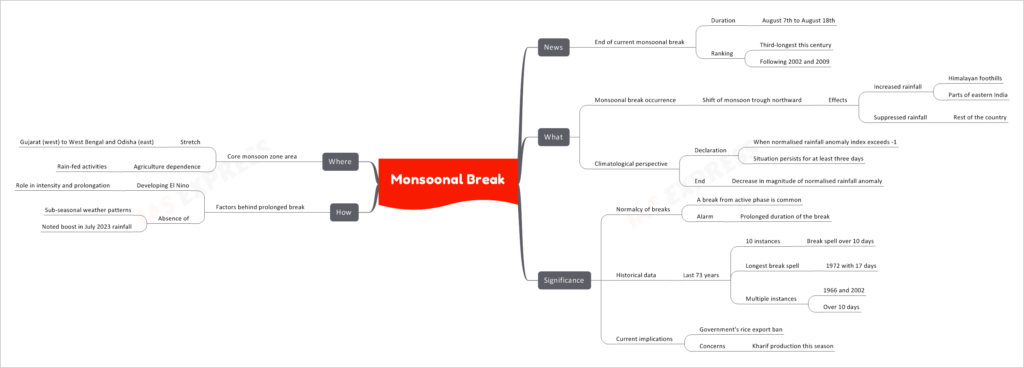Monsoonal Break

Monsoonal breaks are periods of suppressed rainfall amid the monsoon season, impacting various regions across the Indian subcontinent. The recent break, lasting from August 7th to August 18th, is noteworthy for its extended duration and the consequential effects it has had on different parts of the country.
Understanding Monsoonal Breaks
Monsoonal breaks occur due to the northward shift of the monsoon trough, a belt of low pressure. This shift results in two distinct effects on rainfall patterns:
- Increased Rainfall: Regions along the Himalayan foothills and parts of eastern India experience increased rainfall during the break.
- Suppressed Rainfall: The rest of the country, including areas in the core monsoon zone, witnesses a decline in rainfall.
Climatological Perspective
Monsoonal breaks are declared when the normalized rainfall anomaly index falls below -1 and this situation persists for at least three consecutive days. The end of a break is characterized by a decrease in the magnitude of the normalized rainfall anomaly.
Significance of Monsoonal Breaks
While a break from the active monsoon phase is common, prolonged breaks like the recent one raise concerns. Historical data spanning the last 73 years reveals that breaks of over 10 days have occurred in 10 instances. The longest break spell was observed in 1972, lasting for 17 days. Multiple instances of prolonged breaks, such as in 1966 and 2002, have persisted for over 10 days.
Implications of the Current Break
The recent monsoonal break has raised concerns about the implications for Kharif crop production this season. The government’s decision to ban rice exports highlights the potential impact of this break on agricultural productivity.
Factors Behind Prolonged Breaks
Prolonged breaks can be attributed to several factors, with a developing El Niño playing a significant role in influencing the intensity and duration of these breaks. The absence of sub-seasonal weather patterns, coupled with a boost in July 2023 rainfall, further contributed to the current situation.
Core Monsoon Zone: Where It Matters
The core monsoon zone spans from Gujarat in the west to West Bengal and Odisha in the east. This region heavily relies on rain-fed activities for agriculture, making the patterns of the monsoonal breaks of paramount importance for the livelihoods of millions of people.
If you like this post, please share your feedback in the comments section below so that we will upload more posts like this.

